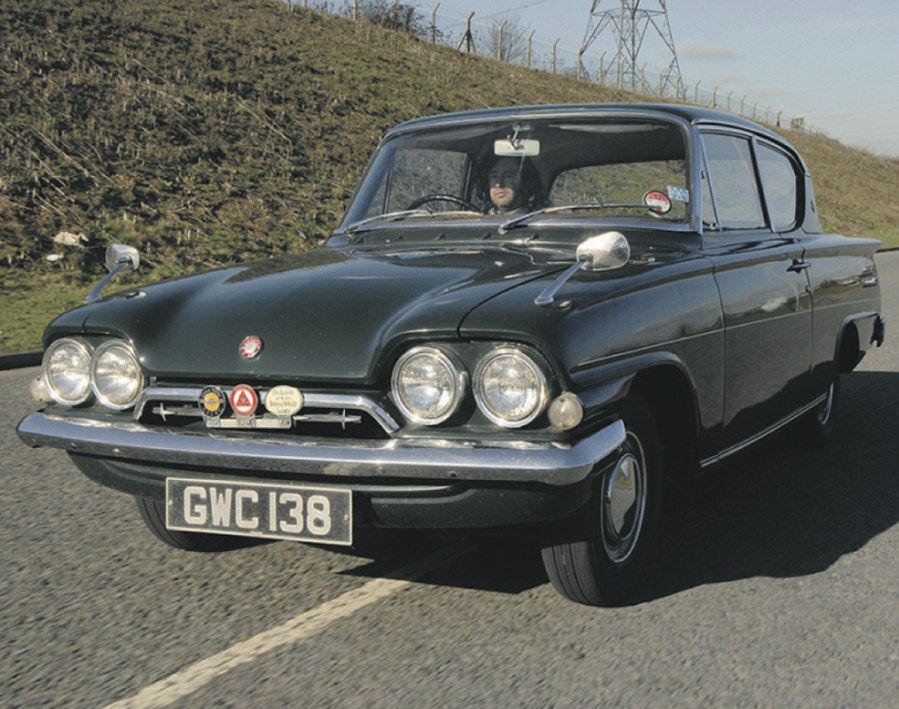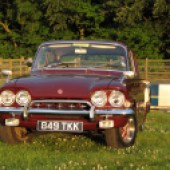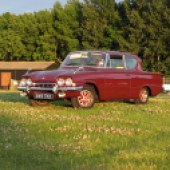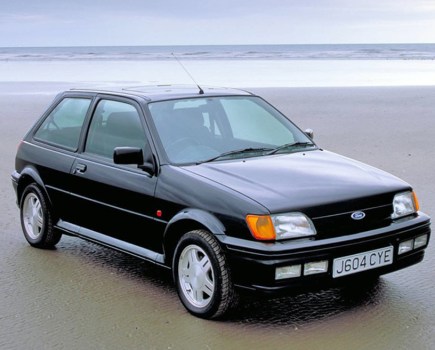The Consul Classic and Capri are rare examples of a marketing misstep by Ford. But there was little wrong with the cars themselves and they make an eye-catching classic choice today
Words: Jack Grover
By the mid-1950s, Ford had recognised the need for a mid-size car – the company had no offering aimed at the middle of the market, which was rapidly being dominated by British domestic models such as the Austin Cambridge and Hillman Minx. Work on a mid-size Ford began in 1956, gaining extra urgency when Vauxhall launched its Victor mid-size model in the UK in 1957.
Ford’s strategy was to reuse the Consul name – already associated with the four-cylinder versions of its larger models – for the new mid-size cars, leaving the Zephyr and Zodiac as its flagship range. Development shared components with the ‘105E’ Anglia; the new Consul would employ the same ‘Kent’ OHV engine, and its platform and running gear would largely be an expanded version of the Anglia’s. Styling also drew inspiration from a similar source, incorporating flashy elements from contemporary American Fords – particularly the Thunderbird and Galaxie – such as a low-set front, quad headlights under ‘eyebrow’ wings, a creased waistline and out-turned tail fins.
The new Consul range comprised two models. There was the Consul Classic saloon, offered in two- or four-door form with an Anglia-style reverse-rake rear window. And there was the Consul Capri, featuring a sleek pillarless coupé roofline and panoramic rear windows. However, the Anglia’s runaway success following its launch in the autumn of 1959 meant that resources and production capacity earmarked for the new Consuls were redirected, delaying the Classic’s introduction until the spring of 1961. British sales of the Capri did not begin until January 1962. By then, the market gap the cars were intended to fill had already been taken by rivals, and tastes had shifted; the Thunderbird and Galaxie models whose styling had inspired the Consuls were no longer in production, replaced by very different designs.
The 1.3-litre Consuls were not only underpowered compared to their rivals but also burdened by the weight of extensive steel, chrome and glass. Performance was modest, though the cars’ ride quality earned praise. A four-speed gearbox with floor-mounted lever and front disc brakes were standard, and the Kent engine was smooth, free-revving and economical. The Consul Classic was among the first British cars to feature multi-speed windscreen wipers, a cigar lighter and a headlamp flasher.
Ford improved performance by fitting a 1.5-litre Kent engine by the end of 1962, but sales had already demonstrated that the Classic and Capri had missed their target. The immediate and formidable success of the sleeker, simpler, smaller Consul Cortina confirmed there was little future for the Classic and Capri. The executive-focused Consul Corsair replaced the Classic in October 1963, while the Consul Capri was withdrawn in the summer of 1964, by which time a more powerful Cosworth-tuned version had been launched. However, this was insufficient to rescue the fortunes of two models that were, at once, outdated and ahead of their time. The Capri name would, of course, return later in the 1960s on another coupé built on Cortina underpinnings, this time achieving phenomenal success.

Ford Consul Classic & Capri values
Inevitably the Consul Capri is significantly more valuable than the Classic. Prices for decent coupes start at £10,000 for one that’s solid and presentable but will probably have a non-original interior, and perhaps some later mechanical parts. One with the original interior in good condition and high-quality paintwork with all matching colours and trim will be £20,000, and a fully restored Capri in concours condition will go for £25,000-£30,000. Viable projects will be worth £3000-£5000.
The Consul Classic is much more affordable, with £12,000 being the price for the very best examples in restored or highly original condition. An solid but average one, perhaps with some non-original trim or an older respray in a non-original colour, will be £5000-£7000 and a project case will be £1000 or so.
Insurance Costs
1964 Ford Consul Capri GT, £15,000 value
Example quote: £95 or £113 with Agreed Value.
Quotation supplied by Lancaster Insurance. Tel: 01480 400761
Quote based on a 45-year-old marketing manager, access to another car, no claims or convictions, club member, 3000 miles per year, no modifications, living in SP2 0HL. Disclaimer: Subject to underwriting criteria. An additional charge may be payable. Authorised and regulated by the Financial Conduct Authority.
Bodywork
Both the Ford Consul Classic and Capri have a reputation for rust issues. In reality, they aren’t any worse than other mass-produced saloons from the late 1950s and early 1960s, and they were popular as secondhand purchases thanks to their relatively thick panels and floorpans. That was a long time ago now, though, and those stylish lines can conceal all sorts of moisture traps and seams where rust can take hold. Check the sills (inside and out), the bottoms of the doors, the wheel arches (both sides), the lower rear section of the front wings, the areas around the headlamps, and the entire length of the waistline and tail fin on the rear wing, particularly where it merges with the boot lid.
On the Capri, water from the side window seal drains into the sill cavity – the drain holes at the base of the sill often become blocked, allowing rust to develop. Inspect the windscreen surrounds and A-pillars for bubbling paint, as any corrosion here usually means the rust has reached the bulkhead, signalling a full strip-down and restoration will be necessary. Check whether the doors sag on their hinges or scrape the sills; if they do, the bulkhead may have weakened. Examine the floors, footwells, and boot floor for rust. Under the bonnet, inspect the suspension strut mounts, inner wings, and areas around the engine mountings.
The main issue is that all panels are unique to the Classic and Capri, and they were only produced in limited numbers, making repairs expensive. Either you need to source rare original panels or fabricate replacements from scratch. The Ford Classic & Capri Owners’ Club – membership of which is highly recommended if you own, or are considering owning, one of these cars – and Ex-Pressed Steel Panels supply repair panels for the key trouble spots and holds a stock of full panels, but consider that a front wing will run you £970 plus VAT, for instance, and that a rusty Consul will almost certainly need more than one panel.
Some panels are now available as reproductions, and floor and sill panels are more reasonably priced. You may encounter cars patched with filler, poor-quality welds, or even fibreglass wings from a time when steel panels were scarce. Correcting such work is rarely cost-effective. There is a lot of chrome on these cars, and restoration costs can mount quickly. Badges and trim pieces are being remanufactured, but this also comes at a price.

Engine and transmission
If the bodywork is in reasonable shape, you’re more or less on safe ground, as mechanically the Classic and Capri tend to use widely available Ford components that are generally robust and long-lasting. The early 1.3-litre Kent engine is the notable exception – underpowered and fragile, most were quickly swapped for the 1.5-litre or, at the very least, a later five-bearing 1.3-litre from a Cortina. Beyond that, just look out for typical signs of wear on the Kent engine: blue smoke (especially under load, indicating worn bores), excessive ‘breathing’ from the oil filler cap at idle, rumbles from worn bottom-end bearings, or a rattling timing chain and clattery valve gear.
Older Kents can also suffer from rusted core plugs, which cause coolant leaks. If the temperature gauge climbs under heavy use or during prolonged idling, it’s likely the radiator or cooling passages are blocked. There’s no oil pressure gauge as standard, but ensure the warning light doesn’t flicker at idle with a warm engine – if a gauge has been fitted, you should see at least 40psi on the move and ideally 10psi at idle when hot. None of these faults are fatal – Kent engine parts remain readily obtainable (though some standard items, such as non-oversize piston sets and parts for the reverse-flow cylinder head found on these cars, can be surprisingly tricky to source today), and a rebuilt engine typically costs around £1500.
The 1.3-litre cars have what is essentially a 105E Anglia gearbox, whereas the 1.5-litre models introduced the three-rail, all-synchromesh ‘Bullet’ unit, later widely used in the Cortina, Corsair, and performance Escorts. Both gearboxes can be rebuilt fairly easily and cheaply (around £500) if worn. Check that the synchromesh (where fitted) operates smoothly, that the gearbox doesn’t pop out of gear if the throttle is suddenly closed, and that there are no rumbles or howls from worn bearings. On early cars, listen for knocking from chipped teeth on first gear.

Suspension, steering and brakes
The basic mechanical layout – front MacPherson struts with coil springs and lower track control arms, a live rear axle on semi-elliptical leaf springs, and a worm-and-sector steering box with drag links – clearly reveals the Consul’s ancestry as a scaled-up 105E Anglia, and would be familiar to anyone who has worked on other Fords of the 1960s. It is simple, straightforward and durable, provided that structural rust hasn’t compromised the mounting points. But while the layout may seem familiar, many of the individual components are model-specific.
If the struts themselves are worn, you’ll need to source new-old-stock items or good second-hand replacements, which can be both difficult and expensive. Individual bushes and bearings are still available new, so if the strut body is sound enough for an overhaul, it’s not a disaster. Listen and feel for knocking from the top bush, and check for wandering, loose or “baggy” handling on the road. Rear leaf springs can be bought new for around £550 a pair, so if the originals are rusted solid or have sagged, replacement is straightforward.
The steering box itself is long-lived; woolly steering or a car that drifts down the road is more likely due to a worn idler joint on the drag link. New joints, bushes and couplings for the steering system are still obtainable, though replacement steering boxes are not. Existing boxes can be rebuilt, and there is even a conversion kit to fit a modern Escort-style rack and pinion system to a Consul.
Front disc brakes were one of the Consul twins’ selling points. Ironically, the front discs themselves are now unavailable, largely because the remaining stock was snapped up years ago for Anglia upgrades. New calipers can be sourced if there are leaks or wear, and all parts for the rear drums and the remainder of the hydraulic system remain available. Make sure the discs are free from corrosion, pitting, warping or excessive wear, and that the rest of the braking system is intact.

Interior, trim and electrics
The soft furnishings of the Ford Consul Classic and Capri are largely specific to each model, so if the interior is worn, having it retrimmed by an upholsterer is the best option – costly, but worthwhile, and a good way to acquire a car at a reasonable price if the body is sound but the interior is lacking. Two-tone vinyl seats were standard, with cloth and leather being very rare optional extras.
The Consul Capri GT featured an all-black interior, a leathercloth dash top and additional instruments – all of which should be present and correct on any decent example today. The horn rings are fragile with age, prone to breaking, and replacements are scarce, so you ideally want to see one in good condition before buying. Most of the dials and switches were also used on the Anglia and Mk3 Zephyr, so fixing or sourcing them is not too difficult.
The electrics are straightforward, made entirely from standard Lucas, AC Delco and Butler components that are easy to find, either original or reproduced. Just ensure the wiring loom hasn’t become brittle over time (a full rewire would be expensive as ready-made looms are unavailable) and that connectors and earth points are sound – there isn’t much electrical equipment on these cars, but what is there should function correctly.

Ford Consul Classic & Capri: our verdict
Classic in name, and classic in character. This is one of those cars seemingly made to be an enthusiast’s pride and joy. The outdated styling, modest performance and relatively high price that held the models back when new are now irrelevant – these Fords still turn heads wherever they go. They exude late 1950s American charm but at a practical British scale, with widely available and familiar mechanical components. Find one in sound structural and cosmetic condition, and you’ll own a superb classic that’s a genuine piece of Ford history.

Ford Consul Classic and Capri timeline
1961
Ford ‘109E’ Consul Classic saloon launched in April, with 1.3-litre 53bhp engine. Two- and four-door bodies available in Standard or Deluxe trim.
1962
January: Ford 190E Consul Capri coupe introduced.
September: ‘116E’ Consul Classic and Capri models introduced with 1.5-litre 59bhp engine, full-synchromesh gearbox and ‘greased for life’ suspension and steering components.
1963
February: Consul Capri GT launched, with Cosworth-developed engine with higher compression ratio, larger exhaust valves, aluminium intake manifold, four-into-one exhaust manifold and twin-choke Weber carburettor making 78bhp.
October: Consul Classic ends production, with 111,225 produced.
1964
June 1964: Consul Capri productions ends: 19,421 were made, including 2002 GTs.

















